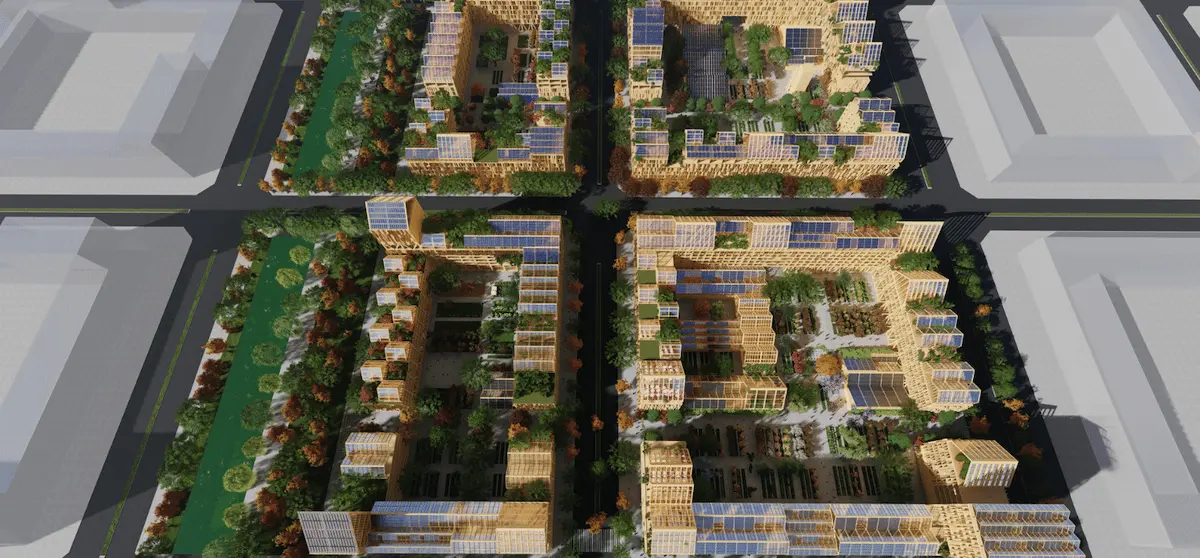Contents
Planet City is a film about a future in which all mankind lives in one city and occupies only 0,02% of the planet. And the rest was given to nature for restoration. Figured out what Planet City looks like and what it is for
What is Planet City
Liam Young is an Australian-born filmmaker and architect. He calls himself a “speculative architect” as his work combines elements of fiction, critical design and technology. In 2016, for example, he directed Into the Sky of Robots, the first film entirely shot using drones.
Planet City is Young’s new concept showcased at the NGV Melbourne Triennial in December 2020. According to it, the entire population of the Earth could live in a giant environmentally friendly city that occupies part of the earth’s surface, freeing the rest of the world to restore the environment. Young envisions that 10 billion people — the entire projected population of the Earth by 2050 — will live in a super-dense, self-sufficient metropolis built according to the principles of a circular economy: everything will be recycled and the city will not produce waste.
Planet City could take only 221 thousand square meters. km, or 0,02% of the planet’s surface, which is about the size of an average US state.
Humans are expected to live in “residential mountains” built from recycled materials and eat food grown in “closed mega farms” and vertical gardens. Buildings will be up to 165 stories tall, power will come from 49,5 billion solar panels, more than 2 algae farms will filter pollution and provide extra food, and more than 4,3 billion bicycles will be needed to get around.
Part of Young’s presentation focuses on the continuous planetary festival that runs through the city and brings together celebrations held by different cultures throughout the year. The viewer sees representatives of urban professions in fancy costumes: divers, shepherds, beekeepers, waste-free weavers.

When Young created the concept, he consulted with scientists and economists. “Planet City only uses technologies that are either already available or currently under development,” he said. For example, “food waste is processed through bioreactors, converted into fertilizer and fish feed, and returned to the system.” He added that he consulted with a NASA microbiologist who is designing closed waste disposal systems for the future of Martian colonies about the possibility of scaling this method.

During the making of the film, Young collaborated not only with scientists but also with creative professionals, including Ann Crabtree, costume designer for The Handmaid’s Tale, science fiction writer Kim Stanley Robinson, and Australian writer and director Ryan Griffen.
Why Planet City appeared
According to Young, his film provocatively explores how “centuries of colonization, globalization and never-ending expansionism” can be reversed to address climate change and the exploitation of both natural and human resources. Young emphasizes that “climate change is no longer a technological issue, but rather an ideological issue rooted in culture and politics.” He has previously attracted the attention of colleagues to global changes. For example, at the Dezeen’s Dezeen Day 2019 conference in London, Young called on architects to increase their influence by applying their skills to video games, instead of designing “rich homes for rich people.”

Young emphasizes that Planet City is just a concept that does not claim to be a real embodiment:
“This is a speculative narrative of what might happen if we radically reversed planetary sprawl. This work of critical architecture is speculative fiction based on statistical analysis, research and traditional knowledge. At the same time, it is both an unusual image of tomorrow and an urgent consideration of the environmental issues we face today.”
Young hopes that one of the roles of this city is a provocation that “makes us see how extreme and absurd the current ways of creating cities are.”
Another project that proposes a radical solution to environmental problems is Masterplanet. Its creators are going to present a general plan for the entire planet using new technologies. For example, they propose to create a single global electrical grid and build floating cities. However, Young fundamentally disagrees with this approach, because it can repeat all the same mistakes that led to the current result: “Plans of this magnitude have historically perpetuated forms of exclusion and strengthened existing systems of power. Most of these projects rarely address and actually contribute to these root causes of climate change.”

Speaking about his inspiration, Young refers to the Half Earth project, developed by biologist Edward O Wilson, which suggests that the mass extinction of animals and plants can be prevented by “mothballing” half of the Earth’s surface.
Green city plans close to reality
If Planet City is pure speculation, a number of other architects are of the opinion that real cities can be sustainable. For example, the Guallart Architects company from Barcelona has developed a project of a self-sufficient city.

The project team has been working from home during the quarantine, so they have included aspects that they think will improve our lives during the lockdown. This includes greenhouses in food-growing buildings and small “collaborative digital factories” that will use 3D printing and rapid prototyping to replace missing or broken items if supply chains are disrupted. Each household will have access to their own outdoor space, as well as a place to work remotely. Solar panels on sloping roofs will power buildings, streets will be prioritized for pedestrians, cyclists and electric taxis, and drones will be used for deliveries.
Daniyar Yusupov, architect of unit4.io, recalls another project:
“Of course, this is far from the first “approach to the piano”, there have been such projects before. I remember one of the most detailed, in my opinion, is the 2016 ReGen Villages, sponsored by Google. Or here is the Niom project – its creators are going to build a hyper-innovative city in the Arabian Desert. The project, in my opinion, has so far been extremely unsuccessful in many aspects, primarily in the aspect of the development of social culture.”

Does provocation work?
The Half Earth project does not propose to accommodate the entire population of the planet in one city, however, it also raises many questions: which half of the Earth should be chosen for life so that everyone has enough food? How to resolve conflicts with a population that does not want to condense? Finally, who will govern the established territories?
Architect Anmol Ahuja says such a provocative idea is bound to draw surprise and criticism, because on a basic level, Yang denies what is probably one of the best aspects of humanity: the diversity of cultures, people, natural features and more. On the other hand, it rids us of some of our most fundamental (though subjectively debatable) evils: boundaries, politics, and governance.
“If you look at this idea from an architectural point of view, due to the huge population of Planet City, it will greatly surpass the Tower of Babel, fire-breathing skyscrapers and giant pyramids from Blade Runner. It is a literal inversion of the expansionist approach in which our cities have grown so far; a reductionist approach in terms of the resources we consume, but mainly by reducing our impact, both personal and collective,” says Anmol Ahuja.
The comments under the Planet City article on architecture and design site deezen.com are mostly negative. Readers emphasize that this idea is impossible to implement and speak ironically about Young’s architectural ideas, but there are also those who understood the idea: “Even as a thought experiment, it reflects how real it is that at some point we will have to act in order to even would partially reverse or mitigate suburban sprawl if we are to tackle the climate crisis,” said one user.
“The approach postulated by the author, known as “speculative design”, already in the name says that such projects are necessary not to discuss their implementation, but to reflect, ask questions that have no place in everyday life. What does our life look like minus nature? Can we fully rely on the development of technology and how fully live only with their help? If not, then why are they so inferior? In the visualization of the project, it is impossible not to feel the ironically apophatic character. That is, he literally appeals to the reaction: “Oh no, not that.” Okay, if not this, then what? What is wrong with us, our apparently not omnipotent technologies, our development? Actually, the crystallization of this suspended issue is, as it seems to me, the ultimate goal of the project.
The remaining questions – whether it is necessary to drive all of humanity into one reservation, whether it will survive in such a hyperconcentration, whether this will help nature, and others – in my sophisticated opinion, are deeply secondary and simply not important. The benefit of them is that they encourage indifference,” says Daniyar Yusupov.
Subscribe to our “Green” channel in Telegram. We publish the latest research, eco-news and tips that will help you live without harming nature.










